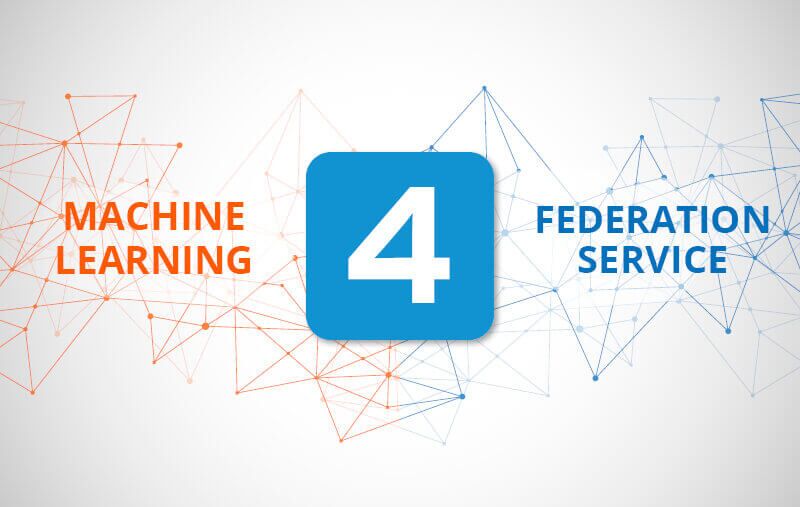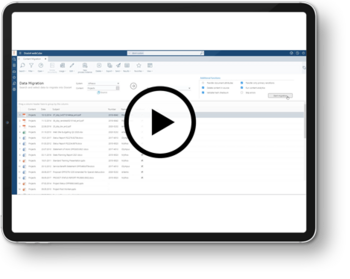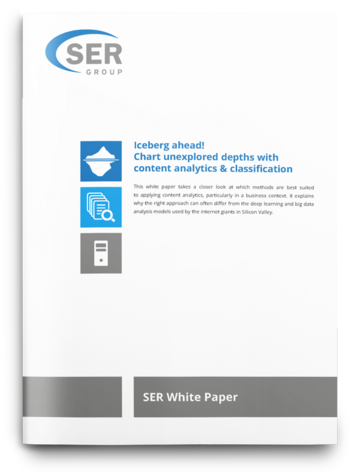SER Blog Innovation & Technology
Milestones in Doxis intelligent information management
Bärbel Heuser-Roth
The new Doxis services for machine learning (ML) and federation are two special services that we developed based on customer feedback and project experience. They are important milestones in the further development of intelligent information management (IIM) for Doxis customers. Here we describe how these new services make daily work for users and IT employees even easier, make cross-system information management more convenient, and help your company to manage its business processes more efficiently.

AI inside: The new Doxis Machine Learning Service
Many companies manage large quantities of data and documents in their archive systems that contains valuable information. Unfortunately, this information often goes unused, because it can’t be captured or, in some cases, even located properly. With Doxis Cognitive Services, companies can utilize the information in Doxis and profit from it in their business processes. Machine learning (ML), in particular, can open the doors to automated access to relevant information by identifying similar content. Sometimes, the relationship between information may not be immediately recognized. With ML, the potential of these relationships can be identified. Doxis also automatically adds keywords to improve searches and help identify who is an expert on a given topic. Doxis ML can even detect risks and make information governance easier by, for example, automatically flagging information that is relevant to statutory regulations and classifying and protecting the corresponding documents.

Intelligent platform consolidation
In this video, you'll find out how Doxis Cognitive Services can help you to transfer & automatically file information and metadata from legacy systems to Doxis. You'll also see how Doxis is constantly learning and becoming more intelligent for future projects.
Watch nowDoxis brings ML to data
The advantage of Doxis is that the cognitive services are embedded in the content services platform. In this way, all applications on the Doxis platform profit from the intelligent services. The same applies to the new Doxis Machine Learning (ML) Service. This service brings machine learning to data and documents where they are located: in Doxis. In this way, it can automatically capture the entire information pool, including information that has already been in Doxis for many years. To create learning sets to train ML algorithms, all content of the ECM system is used as a source of data. Even context- and case-based data can be used to improve the results. This data can be stored in a model.
Doxis learns: Simple training for ML models that are constantly improving
The web interface of Doxis ML makes it easy for users to manage models and train them with updated data as needed. The integrated AutoML classification and comparison with similar content ensure that the ML models are constantly and automatically optimized. As a result, Doxis is always improving. With Doxis, administrators can access earlier versions of trained models at any time, which drastically speeds up the runtime for training: While a current version of a model is being used, the next version is being trained so that it is ready to be used when the current version is done.
AutoML automatically finds the right method & makes work easier for IT
Previously, companies needed their own highly specialized, experienced data scientists with a lot of AI-related know-how to implement concrete ML projects. These scientists ensured that the correct procedures were identified for each use case, the corresponding systems were set up correctly, and the systems were trained appropriately. Thanks to its ability to use AutoML, Doxis streamlines the path to intelligent information management: The integrated AutoML technology automatically tests different ML algorithms for a given project and identifies the most appropriate method for the use case. In this way, machine learning can be utilized even by companies that don’t have the necessary IT infrastructure or personnel resources.
Use case: Improved search & suggestions for similar content
Doxis helps employees with their day-to-day activities, for example, by suggesting values for searching for and filing documents. An algorithm for word associations is used to achieve this. This algorithm identifies relationships between similar words and models them as vectors. In this way, a search can be improved through the inclusion of semantically similar terms, for example.
The classification algorithm integrated in Doxis ML sorts objects into suitable classes such that each object is assigned to exactly one class. The purpose of this is to make it possible to identify similar objects; for example, all documents in a document pool that have a similar main topic. In other use cases, it might be logical to include suggestions, for example, for the three best classes, such as when it is necessary to find people who are experts on a given topic or to determine the main topics of documents.
It is also possible to use any of the cognitive services and incorporate machine learning as a service (MLaaS) – that is, cloud-based ML services (e.g., from Google, IBM, Amazon or Microsoft) – in the Doxis architecture. There is no Swiss Army knife of ML, or, as the ML jargon goes, there is no free lunch. Therefore, various methods are integrated for testing purposes and managed with AutoML so that you can quickly find and use better methods.

Intelligent business with content analytics & classification
Learn here how you can gain valuable insights from your unstructured information and thereby improve how you run your business.
Read nowLess searching, more finding: The new Doxis Federation Service
Intelligent information management with Doxis is not limited to the information in the content services platform. Smooth business processes depend the ability to use IIM across multiple LOB systems: ERP, CRM, etc. With the Federation Service, Doxis opens new doors to integrating external content from these systems.
In many enterprise search approaches, external content is first crawled so that the content (text) can be added to a shared index. Doxis has supported this approach for a while now. The advantage is that documents from third-party applications or from the file system can be handled like the content that’s already located in Doxis: They can be linked in eFiles or processes and included in full-text searches, for example. However, this federated index is not the ideal solution for combining information from differing information sources in some use cases. For example:
• when structured data should be included that isn’t suited for a full-text search
• the content to be included changes frequently and it’s necessary to have real-time versions of the data (crawling is always delayed)
• a federated index would be too large
• crawling is too resource-intensive
Federated search creates a quick, 360° view
Doxis Federation Service offers an alternative for searching third-party systems: Doxis uses virtual (external) information objects to create a view of the third-party system to be searched. In this way, an eFile or workspace in Doxis can create a 360° view of diverse information in a company, including structured information from the ERP or CRM system. This is an exciting use case that begs such a federated search.
With Doxis, various views of the corresponding information from the external systems can be pre-defined, and permissions can be assigned. Examples include customer master data and open customer orders. In this way, users can obtain the information they need for their daily tasks from more than 100 additional systems. Sensitive documents and data remain protected.
We would be happy to demonstrate how the new Doxis services for machine learning and federation are used for real scenarios either remotely through screen sharing or in person. Book a personalized live demo here ⯈
Bärbel Heuser-Roth
For many years now, Bärbel Heuser-Roth has been dealing with a wide variety of ECM topics, from information logistics, process management and compliance to the use cases of intelligent processes for automated information management. She has also spent her career researching and writing about the implementation of ECM projects at companies and organizations.

The latest digitization trends, laws and guidelines, and helpful tips straight to your inbox: Subscribe to our newsletter.
How can we help you?
+49 (0) 30 498582-0Your message has reached us!
We appreciate your interest and will get back to you shortly.




